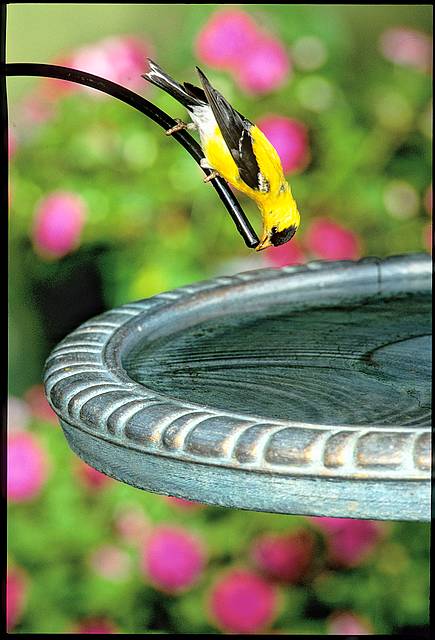-
Recycled Finch Feeders for Earth Day & Always
Happy 41st Birthday Earth Day!
Recycle and Reuse… that’s the deal to minimize your carbon footprint. In all facets of life-including backyard birding, there so many recycled products from which to choose. Recycled plastic finch feeders, and every other kind of feeder and birdhouse seriously help to keep plastics out of our landfills.
A recycled bluebird feeder I purchased a few years ago came with a sticker saying how many plastic jugs were used to make this item. It wasn’t a “stock” sticker either, because the number 33 was hand written on it. Besides that… the feeder still looks brand new after three years!
These new recycled finch feeders are pretty cool too as they feature “all-over” feeding space. Unlike traditional tube feeders that have perches, these finch feeders have something called “magnet mesh” which is very attractive to clinging birds such as finches.
Consider making your next finch feeder, oriole feeder, bluebird or woodpecker feeder a recycled plastic one. The non-porous surface is easier to clean and minimizes mold and bacterial growth. They won’t warp, crack, split or fade, and it’s likely the feeder (or house) will still look new after several years of use. Recycled is a wise investment and saves money in the long run because the product lasts!
-
why use an upside down finch bird feeder?
Too many finches in your yard… House Finches, Purple Finches stealing all the “black gold” known as nyjer (or thistle)? Here’s a tip you may not be aware of: Goldfinches are the only finch who will feed while perching upside down. Enter the upside down finch bird feeder! It discourages other finches while attracting American Goldfinches.
It’s exclusively for Goldfinches and really does the trick if your finch bird feeder is requiring too many trips to fill. One thing I’ve noticed in our yard is the finch feeders’ activity seems to cycle. Constantly gorging on thistle all winter, these feeders have less activity right now, while the finch bird feeders with mixed seed are jammed-packed mobbed.
Goldfinches have the latest nesting season of most song birds, so you can bet thistle feeders will once again be bustling from late June through the summer months. With dandelions out in full force, Goldfinches are also feasting on this favorite while the pollen flies and settles here in the southeast. If your finch bird feeder is seeing little or no activity now – be patient and don’t give up just yet. Warmer summer months will bring increased activity and vibrant yellow hues to yard! If the food sits too long though, it my spoil with heat and humidity, so just be sure thistle is fresh for all your new visitors.
Hanging some nesting materials in the yard will also encourage Goldfinches and others to take up residence at your place. Timing is key, so have materials out before the nesting season begins. Whether commercial nest materials, or easy home made ones, you’ll entice more feathered friends to stick around!
-
habitat and thistle feeders for Goldfinches
Although American Goldfinches are a rather common songbird, it’s a favorite of many backyard birders. With a nickname of “yellow canary” the summer plumage of male Goldfinches is almost electric! Keeping thistle feeders out year-round will almost ensure that vibrant yellow color will grace your yard in warmer months.
Habitat plays an important role in attracting any wildlife, and sometimes doing less work is better than doing more. Dandelions happen to be a favorite of goldfinches’, as are spent marigolds, cosmos, zinnias and coneflowers. Don’t dead-head these flowers, better off to leave them as treats for birds to feast.
Water is another key element in attracting finches or any wildlife for that matter. Fresh water in a birdbath will always provide an excellent resource for my species of birds. Keep a fresh water source near thistle feeders to further entice Goldfinches to your place.
Because their nesting and breeding starts so late in the season, you can expect a great increase of activity at thistle feeders in July and August. Parents feed chicks thistle exclusively, so feeders can get rather crowded. And because of their sweet nature, a Goldfinch is more likely to fly away from a crowded thistle feeder than to fight for a perch. If you’d like to attract these super-sweet songbirds, you may want to consider adding an extra thistle feeder in your yard this season.




